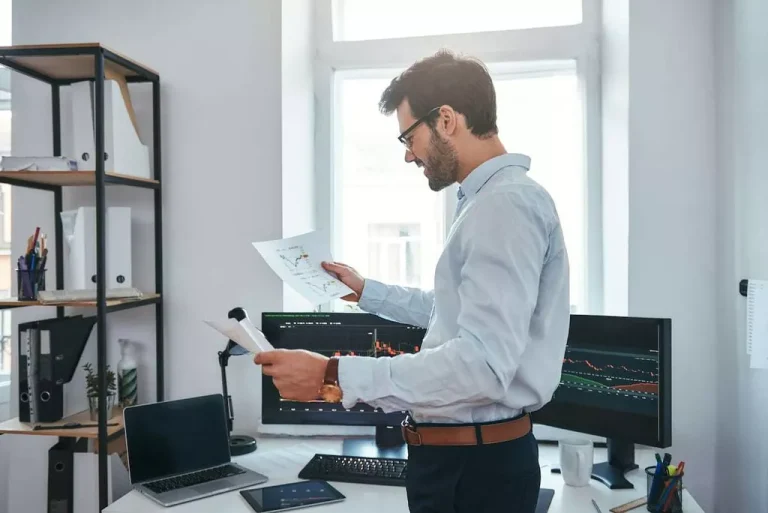Understand Automated Trading Systems: A Comprehensive Guide
Content
The cost of acquiring the necessary hardware, software, and data feeds can be substantial. Additionally, continuous monitoring and updates are required Fintech to ensure the system remains effective in changing market conditions. Automated trading systems operate based on pre-defined rules, which can sometimes be a limitation. In dynamic market conditions, human judgment and intuition can play a crucial role in making quick decisions. Relying solely on automation may lead to missed opportunities or suboptimal trades.
Automated Trading Systems: The Pros and Cons
VWAP is calculated by taking the average price of an asset throughout a trading period, weighted by https://www.xcritical.com/ volume. The algorithm seeks to execute trades at intervals that approximate this average price. Algo traders are market participants who use algorithms to automate their trades.
What Do Trading Bots Do on the Internet?
This swift order entry can be crucial in rapidly moving markets, potentially averting fast trading platform major losses if the trade goes against the trader. Technical day traders will use autotrading to invest based on technical market signals. These types of orders allow an investor to specify an entry price and build a collar around the trade to institute predetermined profit and loss levels for risk management. This concept involves testing a particular trading strategy using previous statistical market data.
How Africa’s Mobile Money Boom Faces Rising Fraud Risks

In addition to that, it can be used to trade commodities such as gold, oil, and copper, using strategies such as trend-following, mean-reversion, and statistical arbitrage. A rule may be set to adjust the size of a position based on the level of risk or the account balance. The Time Weighted Average Price (TWAP) strategy is similar to the VWAP strategy but focuses purely on time rather than volume. Open-source algorithms are algorithms where the code and logic are fully accessible, available and modifiable by the public, unlike black-box algorithms.
Are There Risks Involved in Autotrading?
Monitoring is still required to ensure that it is working correctly and to avoid unexpected failures. Moreover, the details of the rules may vary as infinitely as the individual investor’s preferences. Some depend on strategies like picking market tops, whereas others prefer following investing trends. Since rules can get triggered by prices, volumes, and other data on market activity, the automated trading system is restricted to the use of technical indicators.
Once the rules have been established, the computer can monitor the markets to find buy or sell opportunities based on the trading strategy’s specifications. Depending on the specific rules, as soon as a trade is entered, any orders for protective stop losses, trailing stops, and profit targets will be automatically generated. In fast-moving markets, this instantaneous order entry can mean the difference between a small loss and a catastrophic loss in the event the trade moves against the trader. In fact, 70% to 80% of shares traded on U.S. stock exchanges come from automatic trading systems as of 2024. Based on those functions, they also provide modern AI to users to use advanced strategies without the need to program.
- There are definitely promises of making money, but it can take longer than you may think.
- Moreover, robots monitor the market and help beginners enter positions at best possible time.
- As an Investopedia fact checker since 2020, he has validated over 1,100 articles on a wide range of financial and investment topics.
- This ability allows traders to diversify their trading, spreading risk across different instruments and strategies, and can help to create a hedge against losing positions.
- This ensures that trading opportunities aren’t missed when you’re asleep or away from your computer.
Algo trading or algorithmic trading is the mechanism in which computer-generated algorithms are used to execute trades, instead of humans. The trading instructions are programmed into the trading software in the form of algorithms, with reference to variables like time, volume and price. In turn, the computer makes the trade according to the instructions given to it.

Over-optimization is another risk that comes with using automated trading apps. These solutions often deliver backtest results that look good on paper but are not applicable in real-world trading situations. Therefore, traders must continuously monitor their devices to prevent unauthorized transactions as a result of mechanical problems. Manually monitoring your devices’ statuses can be exhausting and could take a toll on every trader. It also eliminates the bias and errors from backtests since insights are based on the information you input.
The Algobot dashboard’s simple, easy-to-navigate interface means that users will not be put off by the tool if they have little or no background in trading. Begin with a small portion of your trading capital to test the effectiveness of the automated system. Gradually increase your investment as you gain confidence in the system’s performance. Automated trading can be used to trade cryptocurrencies such as Bitcoin, Ethereum, and Litecoin, using strategies such as trend following, momentum trading, and mean-reversion. Setting up a system to track your performance, such as profit/loss, win/loss ratio, and other key performance indicators. Establishing guidelines for how much you are willing to risk on each trade and how you will manage risk throughout your trading.
By keeping emotions in check, traders typically have an easier time sticking to the plan. Since trade orders are executed automatically once the trade rules have been met, traders will not be able to hesitate or question the trade. In addition to helping traders who are afraid to “pull the trigger,” automated trading can curb those who are apt to overtrade—buying and selling at every perceived opportunity.
However, you still have control over your account, and you can disconnect the bot from your exchange anytime. Strictly Necessary Cookie should be enabled at all times so that we can save your preferences for cookie settings. Yes, dependable sites such as Algobot offer secure transactions through the use of encrypted codes and secure servers. The simplicity of the layout is essential not just for inexperienced but also for experienced users.
Even in volatile markets, when it’s tempting to deviate from the plan, discipline is preserved because the system continues to follow the set rules. In some cases, these rules can be designed with the help of a skilled programmer. Due to shifting market conditions, strategies that perform extraordinarily well in backtesting may not necessarily produce the same results in actual trading. This is because historical data does not necessarily indicate how financial markets will perform in the future.
Automated trading systems operate based on predetermined rules and do not get influenced by emotions, ensuring a disciplined and objective approach to trading. If market conditions change unexpectedly (e.g., during a financial crisis or a sudden geopolitical event), the algorithm may not be able to adapt, potentially leading to losses. Over-optimization occurs when traders backtest their algorithms to the point where they perform perfectly on historical data but fail in live markets. This phenomenon, known as “curve fitting,” can result in disappointing real-world performance.
This makes algo trading quite precise, well-executed, well-timed, and free from most possible human errors. Algorithmic trading involves automatically executing trades based on predefined rules and criteria – such as asset price, volume and the differentials between correlated markets. These algorithms use technical analysis and statistical models to make informed trading decisions.
Technology failures can happen, and as such, these systems do require monitoring. Server-based platforms may provide a solution for traders wishing to minimize the risks of mechanical failures. Remember, you should have some trading experience and knowledge before you decide to use automated trading systems. Traders do have the option to run their automated trading systems through a server-based trading platform. These platforms frequently offer commercial strategies for sale so traders can design their own systems or the ability to host existing systems on the server-based platform.



